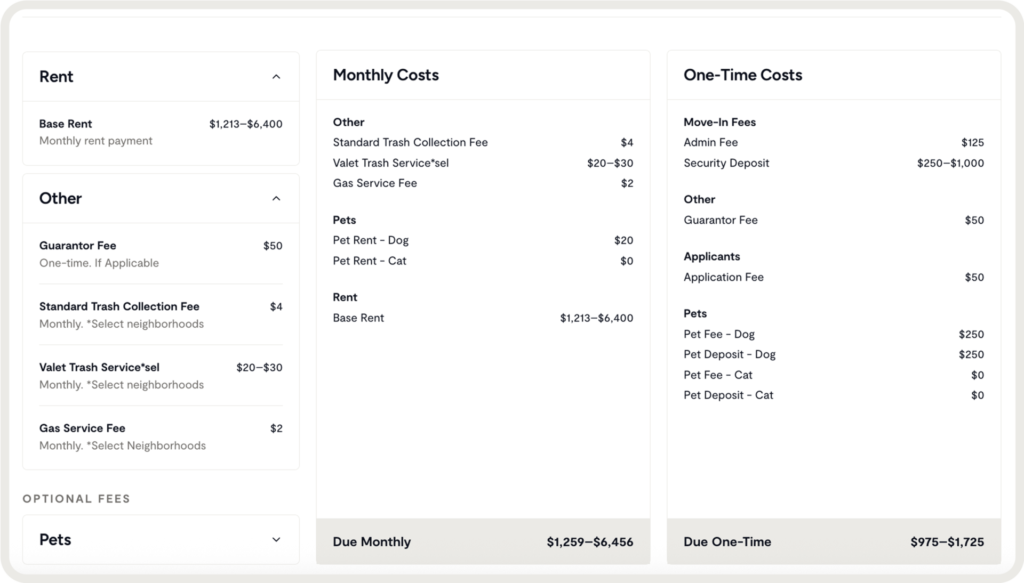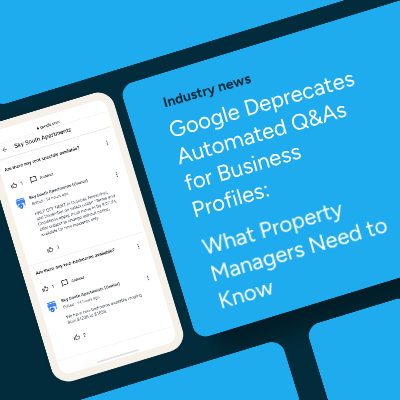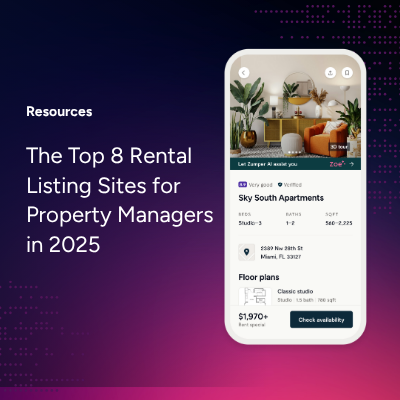
Fee transparency has quickly become the expectation for consumers across industries. Just last year, the FTC released guidelines for hotels, event promoters, and lodging sites to display all-in-pricing before a customer gets to the checkout, according to the Associated Press.
So where does the rental housing industry come in? New laws and regulations are consistently being enacted across the country that require more transparency from property managers and owners.
In this guide, we’ll share what fee transparency really means, how rules vary by state, and practical steps you can take to implement fee transparency anywhere you advertise.*
What is fee transparency?
Why fee transparency matters now
What are types of fees for rental housing?
What states have fee transparency laws?
How to implement fee transparency
What happens if I don’t comply with fee transparency?
Fee transparency compliance checklist
What is fee transparency?
Fee transparency means advertising and presenting the true, all-in price of renting a home up front, before a renter hands over personal info or starts an application. It clearly labels any additional, optional, or variable charges (what they’re for, when they’re charged, whether they’re refundable, and how to opt out if applicable).
Why fee transparency matters now
States and cities are moving quickly to eliminate “junk fees” in many industries, including rental housing with new laws. Laws are already in effect in several states, with more on the way. For example, according to the National Apartment Association, Massachusetts’ new Attorney General regulations took effect on September 2, 2025, explicitly targeting rental housing fees.
What are types of fees for rental housing?
Fees fall in three main categories: Mandatory, situational, and optional. Here are some examples of each of these fee types.
- Mandatory: Any fee or charge required for a renter to lease a unit, even if it’s refundable, like admin fees, application fees, trash, common area utilities, etc.
- Situational: Fees that are required only in specific scenarios. For example, key/fob replacement, unauthorized pet fee, early termination fee, maintenance fees, etc.
- Optional: A cost that does not apply to every renter, and is only charged if a resident opts into it. This includes parking, storage, pet rent, premium services (concierge, Wi-Fi upgrades), etc.
What states have fee transparency laws?
Because there is no federal law in place, fee transparency rules vary by jurisdiction. Here are the states that have adopted fee-transparency rules or laws related to advertising rental listings.
| State | Bill / Rule name | Effective date | Ad requirements |
| Colorado | HB25-1090 | Jan 1, 2026 | Must prominently display one total price that is inclusive of all mandatory fees and charges |
| Connecticut | SB 3 | Oct 1, 2025 | Requires inclusion of any fee, charge, or cost to be included in the total advertised price, “regardless of whether the tenant may opt out of such fee, charge or cost.” Excludes situational fees (pet, replacement key/fob, damage, etc.) |
| Massachusetts | 940 CMR 38.00 | In effect (Sept 2, 2025) | Must disclose the Total Price inclusive of all fees at first point of contact and before collecting personal info; Must include lease term for said price. |
| Minnesota | MN Stat. §504B.120 | In effect (Jan 1, 2025) | Multifamily Dive reported non-optional fees must be disclosed in ads and on the first page of lease; requires “Total Monthly Payment” (rent + non-optional fees) disclosure, and whether or not utilities are included. |
| Nevada | NV AB121 | In effect (Oct 1, 2025) | Must show a single figure representing the maximum total amount of rent that includes any mandatory fees plus base rent |
| New Mexico | SB267 | In effect (June 20, 2025) | Requires housing providers to disclose all costs to applicants including the base rent and an itemized description of all fees in the listing. |
| New York City | FARE Act | In effect (June 11, 2025) | Display all mandatory fees in a clear and conspicuous manner, and give the renter an itemized list of all fees with descriptions that the renter must then sign before signing a lease. |
| Virginia | § 59.1-608 | July 1, 2026 | Clearly display the total price including all mandatory fees or surcharges. |
| Washington (Bellingham) | Ord. 2025-06-010 | In effect (August 1, 2025) | Must disclose rent, all utilities the renter is responsible for, utilities included in the rent, and all optional or mandatory fees. |
How to implement fee transparency
You can implement fee transparency in one of three ways: via your PMS provider, with the help of your supplier partners, and manually.
Step 1: Talk to your PMS
Most enterprise PMSs are working to structure fees as data fields that flow into your marketing channels using the new MITS 5 standard. It was developed by RETTC and the MITS 5 Working Group, which includes Yardi, RealPage, Zumper, Entrata, and many more.
For Yardi users, their MITS 5 feed is complete and now fully integrated with Zumper. Contact your Yardi rep with questions about including detailed fee data in your feed.
For all other PMSs, contact your feed provider to confirm the status of their MITS 5 feed. If they are still in development, move to step 2.
Step 2: Work with your supplier partners
If your PMS is still finalizing the necessary changes to ensure they can easily and reliably pass along your fees, contact your ILS partner(s) directly to ask for support in updating your listings.
For Zumper, simply email our Client Services team at clientservices@zumper.com with your itemized fee inventory (table format is best), and we’ll ensure your listings are updated with the details.
Plus, Zumper listings now include interactive cost calculators, where renters can select optional and situational fees to see their potential total monthly cost for that community, driving higher-quality leads to your leasing teams.
Other industry partners can support you with fee transparency, like EliseAI, to ensure your lead nurturing chatbot reflects your all-in-pricing.
Step 3: Manually update
Check and make sure you have updated your pricing and fees anywhere you advertise online or in print. This includes your ILS listings, Google Business Profile, property website, price sheets, chatbots/widgets, pricing calculators, digital ads, flyers, printed quotes, lease agreements, emails and texts, and more.

What happens if I don’t comply with fee transparency?
Beyond regulatory exposure, non-transparent pricing can negatively impact your lead quality and trust with renters. States are also stepping up enforcement across industries (housing included) against hidden fees and drip pricing practices. Having a durable, structured disclosure process is best-practice.
Fee transparency compliance checklist
- Create one master fee policy per community in a central document.
- Rewrite ad templates to show the all-in price.
- Specify fee types anywhere you advertise pricing, such as optional vs. mandatory vs. situational.
- Standardize wording wherever you detail your fees (e.g., “Valet Trash (Required), $25/mo”).
- Display refundable deposits with conditions (amount + return conditions).
- Keep up with existing and new laws that require fee transparency via industry publications and supplier sites like Zumper Blog.
- Work with supplier partners to access solutions to achieve fee transparency like pricing calculators, widgets, support for all-in pricing via MITS 5-compliant feeds and listings.
- Re-train teams with new scripts and email templates using the updated language and pricing structure.
- Audit quarterly against your toughest jurisdiction to ensure you’re compliant everywhere.
Fee Transparency in Multifamily TL;DR
Fee transparency is now the expectation for renters, and it’s the law in many states and quickly spreading nationwide. Massachusetts, Colorado, Connecticut, Nevada, New Mexico, Minnesota, and New York all require all-in pricing or full fee disclosure in advertising by 2025–2026, with more states expected to follow.
To stay compliant and build renter trust:
- Always display the total advertised price (rent + mandatory fees).
- Clearly label optional vs. situational charges.
- Work with your supplier partners to access solutions that support fee transparency efforts.
- Audit ads, websites, and collateral quarterly to match the strictest jurisdiction.
Contact Zumper’s Client Services team at clientservices@zumper.com for any questions and support with adding your fees to your Zumper listings, and to learn more about our new cost calculators.
*This is not legal advice. Speak with your counsel to establish what steps your firm should take.
Ready to put your listings in front of millions of renters? Contact us to learn more about our best-in-class ILS and our AI-powered, human-perfected marketing enhancements designed to amplify your digital presence.



